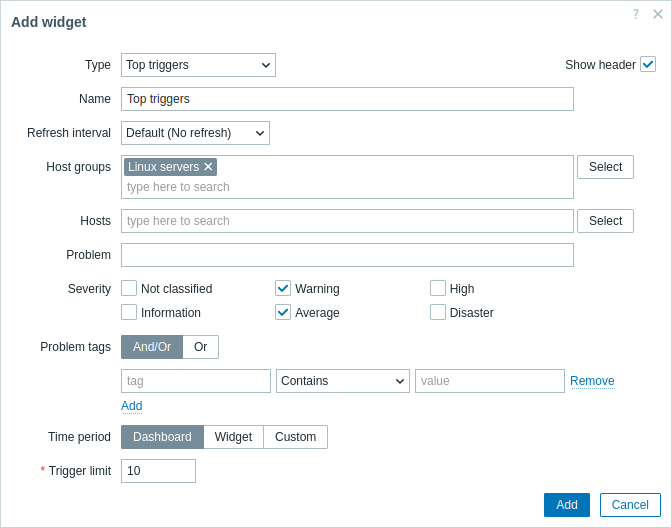Se encuentra viendo la documentación de la versión en desarrollo, puede estar incompleta.
Esta página incluye contenido traducido automáticamente. Si detectas un error, selecciónalo y presiona Ctrl+Enter para informarlo a los editores.
Esta página incluye contenido traducido automáticamente. Si detectas un error, selecciónalo y presiona Ctrl+Enter para informarlo a los editores.
Table of Contents
30 principales triggers
Descripción general
El widget Principales disparadores muestra los disparadores con el mayor número de problemas.

Muestra los mismos datos que *Informes > Principales 100 disparadores* y puede mostrar hasta 1000 registros.
Configuración
Para configurar, seleccione Principales disparadores como tipo de widget:

Además de los parámetros que son comunes para todos los widgets, puede establecer las siguientes opciones específicas:
| Grupos de equipos | Seleccione los grupos de equipos cuyos problemas se mostrarán en el widget. Este campo es autocompletable, por lo que al comenzar a escribir el nombre de un grupo se ofrecerá un menú desplegable con los grupos coincidentes. Al especificar un grupo de equipos principal, se seleccionan implícitamente todos los grupos de equipos anidados. Los problemas de estos grupos de equipos se mostrarán en el widget; si no se ingresan grupos de equipos, se mostrarán los problemas de todos los grupos de equipos. Este parámetro no está disponible al configurar el widget en un panel de plantilla. |
| Equipos | Seleccione los equipos cuyos problemas se mostrarán en el widget. Este campo es autocompletable, por lo que al comenzar a escribir el nombre de un equipo se ofrecerá un menú desplegable con los equipos coincidentes. Si no se ingresan equipos, se mostrarán los problemas de todos los equipos. Este parámetro no está disponible al configurar el widget en un panel de plantilla. |
| Problema | Puede ver los disparadores solo para problemas concretos. Para ello, introduzca la cadena que debe coincidir en el nombre del problema. Las macros no se expanden. |
| Gravedad | Marque las gravedades de los disparadores para filtrar los disparadores que se mostrarán en el widget. Si no se marca ninguna gravedad, se mostrarán todos los disparadores. |
| Etiquetas de problema | Especifique las etiquetas de los problemas que se mostrarán en el widget. Es posible incluir o excluir etiquetas y valores de etiquetas específicos. Se pueden establecer varias condiciones. La coincidencia de nombres de etiquetas siempre distingue entre mayúsculas y minúsculas. Hay varios operadores disponibles para cada condición: Existe: incluye los nombres de etiquetas especificados; Igual: incluye los nombres y valores de etiquetas especificados (distingue mayúsculas y minúsculas); Contiene: incluye los nombres de etiquetas especificados donde los valores de las etiquetas contienen la cadena introducida (coincidencia de subcadena, no distingue mayúsculas y minúsculas); No existe: excluye los nombres de etiquetas especificados; No igual: excluye los nombres y valores de etiquetas especificados (distingue mayúsculas y minúsculas); No contiene: excluye los nombres de etiquetas especificados donde los valores de las etiquetas contienen la cadena introducida (coincidencia de subcadena, no distingue mayúsculas y minúsculas). Hay dos tipos de cálculo para las condiciones: Y/O: se deben cumplir todas las condiciones, las condiciones con el mismo nombre de etiqueta se agruparán por la condición O; O: basta con que se cumpla una condición. |
| Período de tiempo | Seleccione la fuente de datos para el período de tiempo: Panel: utiliza el selector de período de tiempo del panel; Widget: utiliza un widget compatible (establecido en el parámetro Widget); Personalizado: utiliza un período de tiempo personalizado establecido en los parámetros Desde y Hasta; si se establece, se mostrará un icono de reloj en la esquina superior derecha del widget, indicando el tiempo establecido al pasar el ratón. Tenga en cuenta que, independientemente de la configuración de Período de tiempo del widget, los widgets compatibles aún pueden usarlo como fuente de datos para el período de tiempo. |
| Widget | Introduzca o seleccione un widget compatible como fuente de datos para el período de tiempo. Este parámetro está disponible si Período de tiempo está establecido en "Widget". |
| Desde | Introduzca o seleccione el inicio del período de tiempo. Se admite la sintaxis de tiempo relativo ( now, now/d, now/w-1w, etc.).Este parámetro está disponible si Período de tiempo está establecido en "Personalizado". |
| Hasta | Introduzca o seleccione el final del período de tiempo. Se admite la sintaxis de tiempo relativo ( now, now/d, now/w-1w, etc.).Este parámetro está disponible si Período de tiempo está establecido en "Personalizado". |
| Límite de disparadores | Establezca el número de disparadores que se mostrarán. Rango de valores posible: 1-1000. |
© 2001-2026 by Zabbix SIA. All rights reserved.
Except where otherwise noted, Zabbix Documentation is licensed under the following license

